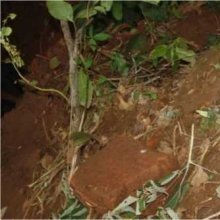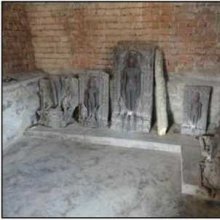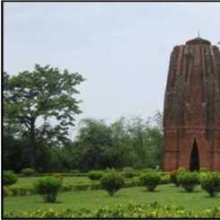Brick: 2 definitions
Introduction:
Brick means something in Hinduism, Sanskrit. If you want to know the exact meaning, history, etymology or English translation of this term then check out the descriptions on this page. Add your comment or reference to a book if you want to contribute to this summary article.
Images (photo gallery)
(+24 more images available)
In Hinduism
Vastushastra (architecture)
Source: Shodhganga: Elements of Art and Architecture in the Trtiyakhanda of the Visnudharmottarapurana (vastu)Brick represents an important Material for the Construction of Temples, which was carefully tested and processed, according to the Viṣṇudharmottarapurāṇa, an ancient Sanskrit text which (being encyclopedic in nature) deals with a variety of cultural topics such as arts, architecture, music, grammar and astronomy.—Brick (in Sanskrit: iṣṭakā) is one of the most important materials in the construction of a temple as it still bears the similar importance even in the modern era. It is a building material which is used to make walls. In ancient time bricks used to be made of clay which were of four kinds, ūṣara, pāṇḍura, kṛṣṇacikkaṇa and tāmraputtaka.
The procedure of making Bricks is very nicely explained in the Viṣṇudharmottarapurāṇa. The book tells that in the brick making process in the first stage all the clay should be dried up in an auspicious ground and thereafter it should be gently mixed with water and moss. After that the dough of the clay should be shaped in a machine which should be one hand in length, half a hand in breadth and one forth hand in height. In that machine the clay should be baked in the fire of wood, cow-dung and grass and thus bricks got prepared. These bricks should be made in proper shape and be arranged skillfully in proper place. This is important to note that only properly baked bricks are accepted for construction. In the Śatapathabrāhmaṇa also, the reference of baked bricks are found which were used for making fire altars during Vedic time.

Vastushastra (वास्तुशास्त्र, vāstuśāstra) refers to the ancient Indian science (shastra) of architecture (vastu), dealing with topics such architecture, sculpture, town-building, fort building and various other constructions. Vastu also deals with the philosophy of the architectural relation with the cosmic universe.
Shilpashastra (iconography)
Source: Shodhganga: Elements of Art and Architecture in the Trtiyakhanda of the Visnudharmottarapurana (shilpa)Bricks in Sanskrit are denoted by Iṣṭakā and is used in the process of creating a Canvas, in the ancient Indian art of Painting (citra), according to the Viṣṇudharmottarapurāṇa, an ancient Sanskrit text which (being encyclopedic in nature) deals with a variety of cultural topics such as arts, architecture, music, grammar and astronomy.—In the Viṣṇudharmottarapurāṇa, it is suggested that before going to start Painting on walls one should plaster a wall. For the process of kuḍya i.e., plastering on a wall, the painter needs iṣṭakācūrṇa i.e., powder of bricks and mṛd i.e., clay as basic ingredients. To prepare this at first the powder of three kinds of brick and one third of clay should be mixed.

Shilpashastra (शिल्पशास्त्र, śilpaśāstra) represents the ancient Indian science (shastra) of creative arts (shilpa) such as sculpture, iconography and painting. Closely related to Vastushastra (architecture), they often share the same literature.
See also (Relevant definitions)
Ends with: Baked brick.
Full-text (+551): Ishtaka, Pakveshtaka, Ishtika, Koshthaka, Aishtaka, Ginjaka, Ishtakarashi, Sudhamaya, Vitabandi, Dagdheshtaka, Ameshtaka, Italem, Jhamaka, Ishtakagriha, Imarata, Sudha, Prathameshtaka, Kuttumanam, Mahidurga, Ita.
Relevant text
Search found 167 books and stories containing Brick; (plurals include: Bricks). You can also click to the full overview containing English textual excerpts. Below are direct links for the most relevant articles:
Satapatha-brahmana (by Julius Eggeling)
Kāṇḍa VIII, adhyāya 7, brāhmaṇa 2 < [Eight Kāṇḍa]
Kāṇḍa VIII, adhyāya 3, brāhmaṇa 1 < [Eight Kāṇḍa]
Kāṇḍa VI, adhyāya 2, brāhmaṇa 3 < [Sixth Kāṇḍa]
Stupas in Orissa (Study) (by Meenakshi Chauley)
Minor Structural Stupas at Udayagiri (Eastern Zone) < [Chapter 4]
Major Stupas at Ratnagiri < [Chapter 4]
Major Stupas at Langudi < [Chapter 4]
The Sacrifices of Rajasuya, Vajapeya and Ashvamedha (study) (by Aparna Dhar)
Details of the Agnicayana (fire-building ceremony) < [Chapter 5 - Minor sacrifices and their Political Significance]
Dichotomic interpretation of the Agnicayana Sacrifice < [Chapter 6 - Dichotomic interpretation of the Major and Minor sacrifices]
Importance of the Brāhmaṇa literature < [Chapter 1 - A brief outline of the Brāhmaṇa Literature]
Parables of Rama (by Swami Rama Tirtha)
Story 89 - The Greatest Obstacle < [Chapter XII - Obstacles]
Story 139 - Hatha Yoga Samadhi < [Chapter XXI - Spiritual Powers]
Two Short Stories < [January - March 1977]
The Out-House < [March 1946]
Modern Scientific View of Human Uniqueness < [October – December, 2001]
The civilization of Babylonia and Assyria (by Morris Jastrow)





